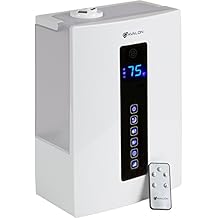Humidity plays a critical role in maintaining comfort and health in our homes and workplaces. Understanding how humidity affects our environment is essential for achieving optimal indoor air quality. This article explores the science of humidity control and highlights the importance of using a combination unit for effective management. We will delve into the mechanics of humidity, discuss the benefits of proper humidity control, and provide insights into why a combo unit is an efficient solution.
Understanding Humidity: What Is It?

Humidity is the concentration of water vapor present in the air. It is expressed as a percentage, known as relative humidity (RH), which measures the current amount of moisture in the air compared to the maximum amount the air can hold at a given temperature. There are two main types of humidity:
- Absolute Humidity: This refers to the actual amount of water vapor in the air, usually measured in grams per cubic meter (g/m³).
- Relative Humidity: This is the percentage of moisture in the air relative to the maximum amount of moisture the air can hold at a specific temperature.
For example, if the air can hold 20 grams of water vapor at a certain temperature, and it currently has 10 grams, the relative humidity would be 50%.
The Science of Humidity and Its Effects

Humidity significantly impacts our daily lives. It affects not only our comfort but also our health and the integrity of our homes. Here are some of the key scientific implications of humidity:
- Comfort Levels: High humidity can make the air feel warmer than it is, while low humidity can make it feel cooler. The ideal indoor relative humidity level is generally between 30% and 50%.
- Health Implications: High humidity can lead to mold growth, dust mites, and other allergens, while low humidity can cause dry skin, respiratory issues, and irritation of the eyes and throat.
- Structural Integrity: Excess moisture can damage wood, paint, and other materials, leading to costly repairs. Conversely, dry air can cause wood to crack and split.
The Importance of Humidity Control

Maintaining optimal humidity levels is crucial for comfort, health, and the protection of property. Here are some benefits of effective humidity control:
- Enhanced Comfort: Proper humidity levels can improve thermal comfort, making spaces feel more pleasant.
- Improved Air Quality: Regulating humidity minimizes allergens and irritants, contributing to better indoor air quality.
- Energy Efficiency: Controlling humidity helps HVAC systems operate more efficiently, leading to lower energy bills.
- Preservation of Property: Maintaining appropriate humidity levels helps protect furnishings, flooring, and structural materials from damage.
What is a Combo Unit?

A combo unit, or a combination dehumidifier and humidifier, is a single device designed to regulate both humidity levels in a space. These units are particularly beneficial for environments where humidity levels fluctuate due to seasonal changes or other factors. Here’s why combo units are essential:
- Dual Functionality: Combo units simplify humidity management by providing both dehumidification and humidification in one device.
- Energy Efficiency: By using a single appliance to control humidity, homeowners can save on energy costs compared to running separate devices.
- Space-Saving Design: Combo units take up less space than having two separate appliances, making them ideal for smaller homes or apartments.
- Automated Control: Many combo units come with smart features that allow for automated humidity regulation, ensuring optimal indoor conditions without constant manual adjustments.
Case Studies: Real-World Applications of Combo Units
Several case studies demonstrate the effectiveness of combo units in various settings:
Case Study 1: A Family Home

A family in a coastal region experienced high humidity levels during the summer and dry air in winter. They installed a combo unit that automatically adjusted humidity levels, resulting in:
- A significant reduction in mold growth.
- Improved respiratory health for family members with allergies.
- Lower energy bills due to more efficient HVAC operation.
Case Study 2: An Office Environment
An office building struggled with employee discomfort due to fluctuating humidity levels. After implementing combo units throughout the space, the results included:
- Increased employee productivity due to improved comfort.
- A decrease in sick days associated with respiratory issues.
- Enhanced preservation of office equipment and furnishings.
Statistics on Humidity Control

Understanding the impact of humidity control can be underscored by relevant statistics:
- According to the Environmental Protection Agency (EPA), maintaining indoor humidity levels between 30% and 50% can significantly reduce the proliferation of mold and dust mites.
- The U.S. Department of Energy reports that proper humidity control can improve HVAC efficiency by up to 30%.
- Research from the American Society of Heating, Refrigerating and Air-Conditioning Engineers (ASHRAE) indicates that buildings with controlled humidity levels can result in a 10-20% increase in occupant comfort.
Choosing the Right Combo Unit
When selecting a combo unit, consider the following factors:
- Room Size: Ensure the unit can effectively manage humidity levels in the intended space.
- Humidity Control Features: Look for units with smart controls and humidity sensors for automated operation.
- Energy Efficiency Ratings: Choose ENERGY STAR-rated units for optimal energy savings.
- Maintenance Requirements: Consider ease of maintenance, such as filter replacement and tank drainage.
Humidity management is vital for ensuring comfort, health, and the integrity of our living and working spaces. The science behind humidity illustrates its profound effects, emphasizing the need for effective control measures. A combo unit offers a practical and efficient solution for managing humidity fluctuations, combining the benefits of both dehumidification and humidification in one device. By understanding the importance of humidity control, the functionality of combo units, and their real-world applications, individuals can make informed decisions that enhance their indoor environments.
In summary, investing in a combo unit is not just about improving comfort—it’s about safeguarding health and preserving property, making it an essential component of modern indoor living.